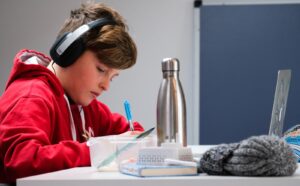Modern society has made education and technology unusual allies.
Now our great challenge is juggling screen time for students.
Children spend seven hours a day riveted to screens, not only for viewing cat videos—though, let’s be honest, who can resist those? The challenge is using these brilliant rectangles to teach our children without turning them into screen zombies.
Yes, they provide doors to knowledge and entertainment, but they also carry great risks to their social skills and general health. On this ride, we have to take the wheel. Teachers and parents, your call to action is this.
Pay close attention: excessive screen time may be the cause of insomnia and high stress.
Students may stop enjoying their preferred activities, grow crankier than a bear in winter, or experience those annoying tension headaches. These are the obvious indicators you cannot overlook.
Indeed, there are red flags waving that demand attention.
How therefore can we design a tech-friendly environment that supports development free from negative effects? This is a useful road map akin to a treasure map but with less pirates and more knowledge:
- Set Screen Time Limits: Establish screen time limits; it’s like imposing a curfew just for screens. Customize the time limits to age and goal:
- Little tots 2-5 years: One hour of quality shows—think Sesame Street, not unceasing trash.
- Bigger children between the ages of six and eighteen should make sure their limits apply across all screens.
- Mix in Breaks: Mix in breaks to urge brief pauses. Eyes need rest; brains like breaks. Every 20 minutes, spend 20 seconds staring at something 20 feet away. You will be thanked by your eyes.
- Promote Activities Off-Screen:Encourage Off-Screen Activities: Get the children moving. Promote reading, outdoor play, or family fun evenings. Based on some CDC data, a little sweat can result in better grades and larger smiles. Work for the prize!
- Talk it Out: Don’t hold back on discussing screen time. Inquire of your students about their internet exploits. Let them contribute to the rule-setting process. If they are on board, like a friendly captain with his crew, things go more easily.
- Work with Schools: Work with teachers to create screen time rules that encourage good behavior rather than merely treating students like statistics. Like delegates at a conference, parents and teachers can both weigh in but with more zeal.
- Make a Screen Time Plan: Create a screen time schedule; visuals help. Draw daily limits and mark educational against recreational use. A schedule can guide students toward better options.
Let’s try for balance and awareness in our moves as we dance with technology in education.
Through active participation in changing screen time rules and fostering digital smarts, we equip our kids to flourish in a tech-sourced environment.
Screen time should be a lifeline to their brilliant future rather than like a chain dragging them down.
Understanding Screen Time: Foundations for Students

With the advent of technology into our daily existence, the phrase “screen time” has become rather popular.
It covers the time students spend on devices including TVs, tablets, computers, and cellphones.
For students especially, screen time can comprise social media, leisure or entertainment, and instructional activities.
Not only for academic success but also for a healthy lifestyle, knowing screen time is vital.
Although it can improve learning and give access to an unimaginable volume of knowledge, too much screen time can cause physical, emotional, and behavioral problems.
Students’ development depends on careful balancing their use of technology.
Guiding children in their relationship with screens mostly falls to parents and teachers.
The Concept of Screen Time
Screen time is the quantity of time people interact with electronic equipment with screens. This covers, but not limits:
- Educational Activities: Online courses, research, and interactive learning tools abound in education.
- Entertainment: Entertainment includes surfing social media, playing video games, and streaming movies.
- Communication: Email, messaging apps, and social media all help with communication.
Knowing these categories enables teachers and parents to evaluate the nature of the screen time their children consume.
Data showing teenagers averaged about seven hours of leisure screen time daily as of 2022, before considering school-related activities, emphasizes even more the need of tracking these interactions.
Advised screen time for several age groups
To strike a good mix, health groups have provided recommendations on screen time. Here is a synopsis rather quickly:
- Children 2-5 years: Children between the ages of two and five should only spend one hour daily viewing high-quality programming.
- Children 6-18 years: Children aged 6 to 18 should be encouraged to have consistent screen time limits on all devices. Steer clear of screens one hour before bed and during dinner.
- Adults: Although not precisely classified, cutting back on leisure screen time can help younger generations follow suit.
Many studies point to the possibility of better patterns as students develop from forming disciplined screen-time routines in childhood.
The CDC reports that too much screen time—especially in childhood—may cause developmental delays and social skill problems.
Students’ Effects from Too Much Screen Time
Students in many different spheres—including academic performance, physical health, and interpersonal relationships—may suffer from too much screen time.
Studies published by the National Institutes of Health linked sleep problems, anxiety, and depression to too much screen time.
Academic Success:
- Distraction: Frequent alerts from social media or entertainment sites might cause one to lose concentration during study sessions.
- Sleep Deprivation: Students who use screens late at night report lower grades because of disrupted sleeping patterns, according a study by the American Academy of Pediatrics.
Physical Condition:
- More screen time is associated with inactive behavior, which fuels child and adolescent obesity.
- Excessive screen time is greatly increasing vision problems including digital eye strain and headaches.
Personal relationships:
- Reliance too much on screens for communication might impede in-person contacts.
- Children who spend too much time on screens may have poorer social skills, which would make forming relationships challenging.
Eventually, community involvement, educational policies, and parenting techniques help to lessen these effects.
Technology’s Place in Contemporary Education
Its influence goes beyond basic instruction; it changes learning opportunities such that they become more relevant and interesting.
Personalized learning made possible by technology motivates students to take active part in their education.
Technology presents many possibilities with easily available educational tools and resources online.
Technology-integrated classrooms foster creativity and teamwork, so arming students for a well-rounded future.
Still, the value of balance is unparalleled.
We have to be alert about the possible dangers of overuse even as education moves more toward tech-based solutions.
How Technology Improves Learning Opportunities
Technology provides dynamic tools that help students grasp and remember, so improving their learning. Some important features include:
- Interactive Learning: Kahoot! and others Quizlet let students participate in gamified learning, so simplifying difficult topics and adding fun.
- Resource Accessibility: Students have access to real-time data from anywhere, at any moment, as well as textbooks and instructional movies. For homework and study, for example, 75% of students said that internet resources were useful.
- Personalized Learning: Adaptive learning technologies change to fit the particular needs of each student, so offering courses that fit their preferred learning speed.
By closing achievement gaps, educational technology helps underprivileged students to have quality education.
However, as technology develops the need of including integrated strategies with conventional teaching approaches becomes more crucial.
The Value of Digital Literacy in Contemporary Society
For pupils in modern education, digital literacy has evolved into a basic ability set.
It covers not only technological proficiency but also knowledge of effective information navigation.
Motives Driving Digital Literacy:
- Informed Decision Making: Students develop the critical ability to separate reliable sources of information from false information in line with the fast dissemination of false information in the modern society.
- Collaboration: Knowing digital tools helps to create cooperative working environments. Given that over 90% of jobs demand digital skills, students must learn early on to be flexible in many different fields.
Investing in digital literacy not only gets students ready for academic success but also gives them the tools they will need in their future professions.
Preferred teaching aids for students
These are some instruments that have won popularity among teachers and students:
| Educational Tool | Purpose | Target Audience |
|---|---|---|
| Google Classroom | Organizes class resources and assignments | Teachers and Students |
| Khan Academy | Offers instructional videos on various subjects | All age groups |
| Duolingo | Language learning through gamification | Language learners |
| Edmodo | Facilitates communication and resource sharing | Students and Teachers |
| Scratch | Teaches coding through interactive gameplay | Young learners |
Frequent assessment of these instruments helps one to understand how successfully they support learning objectives.
Indices of Students’ Screen Overuse
Intervention requires a recognition of symptoms of screen overuse.
Parents and teachers should see behavioral changes, physical symptoms, and emotional signals pointing to too much screen time.
By closely observing these indicators, one can react quickly to support good behavior.
Behavioral Indices to Alert You
Behavioral changes sometimes point to a negative relationship with technology. Some important indicators consist:
- Decreased Engagement in Non-Digital Activities: Reduced Engagement in Non-Digital Activities: A student may be at risk if they show disinterest in past favorite social events or hobbies.
- Increased Irritability: When asked to unplug, a student might react angrily or with frustration, implying over-dependence on devices.
- Decline in Academic Performance: Decline in Academic Performance: One can directly connect an increase in screen time to a sharp drop in grades or interaction with schoolwork.
Parents should have open talks with their children to find out the reasons behind these changed behavior.
Physical Remarks Regarding Screen Overuse
Many physical symptoms can follow from too much screen time. Some grievances to be alert for are:
- Eye Strain: Common among those who spend long hours in front of devices are symptoms including blurred vision or discomfort when looking at screens.
- Headaches: Regular screen use might cause ongoing tension headaches.
- Poor Posture: Long hours on devices could cause backaches or joint pain, particularly in cases when students are not seated correctly.
Encouragement of good practices like frequent breaks helps to reduce some physical discomfort connected to extended screen use.
Emotional Signs of Unchecked Screen Time
Beyond obvious symptoms, emotional indicators can also highlight too much screen time engagement. Important emotional symptoms are:
- Anxiety or Stress: Students who used screens heavily often reported higher levels of anxiety and stress, according a poll taken by the American Psychological Association.
- Isolation: Students who spend more time online could feel more cut off from peers, which would cause loneliness.
- Mood Swings: That is, changes in emotional stability—may show up as irritability or moodiness devoid of screens.
Knowing these emotional reactions helps parents approach the topic sensitively and apply changes that improve general mental health.
Techniques for Juggling Students’ Screen Time
Students’ general health and well-being depend on their screen time being in balance.
Using good policies will help to establish a disciplined environment that preserves the advantages of technology and reduces its negative consequences.
Clearly Defining Usage Boundaries
A good balance in screen time depends on setting limits. Boundary setting techniques include:
- Defining Usage Limits: Parents and teachers should co-create specific times when screen use is permitted, say just during homework or following completion of chores.
- Designated Areas: Create designated areas for screen use, such the living room, which lets one under supervision. This reduces too much private screen time in bedrooms or isolated spaces.
The Value of Planned Breakdowns
Both physically and psychologically, planned breaks during screen time help. Typical break benefits include:
- Enhanced Focus: Short breaks during study sessions can help to increase focus and output. Studies reveal that students can perform better on tasks needing consistent attention following a five to ten minute break.
- Eye Health: One excellent way to reduce digital eye strain is the 20-20-20 Rule. A student should spend at least twenty seconds looking at something twenty feet distant every twenty minutes.
Developing better study habits requires students to create a disciplined schedule including these breaks.
Participating in Non-Screen Games
Combining non-digital pursuits with screen time helps students have a well-rounded experience. Here are several choices to give thought:
- Physical Activities: Encourage participation in sports or outdoor play to advance physical health. Regular physical activity among children shows better mood and academic performance, according a CDC study.
- Creative Hobbies: Crafts, reading, or writing help one be creative without screens, so developing useful skills.
- Family Time: Reading greatly enhances cognitive ability and academic success, claims the National Endowment for the Arts.
Participating in family events enhances relationships and encourages better living choices.
Encouragement of varied and interesting events can help to lead a balanced life that respects real-world experience as well as technology.
Parental Guidance for Managing Screen Time
Parents greatly influence how their kids view technology.
By aggressively tracking and controlling screen time, they can help students create good habits.
Open lines of contact with schools improve these initiatives.
Tips for Parents Watching Consumption
Good observation helps parents to know how technologically active their children are. Among the strategies are:
- Setting Up Screen Time Controls: Parental controls let you set limits on devices and apps, so controlling screen time.
- Regular Check-Ins: Frequent Check-ins: Invite students to share their opinions by scheduling regular conversations on screen time and how it affects them.
- Creating a Family Media Plan: Writing a family media plan will help you to balance leisure and educational time by specifying suitable screen use.
The need of proactive involvement is highlighted by a 2022 poll showing that only 30% of parents routinely discussed screen time with their children.
Promoting transparent technology use communication
Open communication about technology can help to foster trust. Advice on improving communication includes:
- Talking about online safety: Help kids to share their experiences and teach them about possible risks without inspiring anxiety.
- Involving Children in Problem-Solving: Including children in problem-solving helps them to develop responsibility for their use of technology when difficulties surface.
- Leading by Example: Parents should set good screen habits for themselves, so displaying balance in their use of technology.
Open communication becomes the basis, encouraging a good relationship with screens and generating group solutions.
Working with Schools for Complementary Strategies
Parents and schools can cooperate to provide a logical method for controlling screen time. Recommendations for cooperation consist in:
- Participating in Parent-Teacher Associations: By supporting school projects, one promotes the sharing of ideas and increases knowledge of the influence of technology in education.
- Attending Workshops: Schools sometimes hold seminars on screen time, digital literacy, and responsible technology use, which would be very beneficial for parents.
- Creating Family-School Partnerships: Establishing family-school partnerships by means of technology use policies helps to ensure consistency between home and educational settings, so facilitating the student transition.
Parents and teachers presenting a united front helps to create a supportive environment that lets students flourish in a technologically advanced world.
Making Students’ Screen Time Plan
Maintaining balance and making sure technology fulfills its intended use depend much on having a disciplined screen time schedule.
A well-designed plan will include recreational as well as educational screen use.
Components of a Workable Screen Time Plan
A good screen time schedule should comprise several elements:
- Daily Limits: Set a daily screen time limit catered to age and type of activity. Track time use efficiently with apps.
- Purposeful Screen Time: Differentiate between recreational and instructional use in your intentional screen time. For example, whereas recreational use might allow an extra hour of screen time for games or movies, educational use might include one hour of homework-related screen time.
- Activities Overview: Create a visual calendar including accessible learning materials and leisure activities to help students choose good screen habits.
Establishing a disciplined surroundings will help one to develop responsibility and respect of limits.
Including Recreational and Educational Value
A schedule of screen time should strike a mix between leisure and learning. Techniques to reach this comprise:
- Integrating Learning with Fun: Combining Learning with Fun: Suggest instructional games and apps like “Prodigy Math” that advance knowledge without compromising entertainment value.
- Family Involvement: Plan family evenings with documentaries or instructional videos interspersed with conversations improving retention and learning.
Common Sense Media claims that parents who screen their children help to improve their emotional well-being and general screen experience.
Frequent Plan Review and Adjustment
Frequent review of the screen time schedule guarantees that it changes with the times of need. Factors to be considered include:
- Feedback Mechanism: Encourage students to offer comments on how well the plan works. This can help one to develop responsibility and ownership.
- Periodic Reassessment: Regular check-ins—perhaps once a month—allow you to determine whether the strategy fits goals for both academic and personal development.
- Adapting to Changes: Changing course may be required if screen time is compromising grades or physical health. Guide these decisions with research and data.
The Evolution of Screen Time in Education
Screen time in education is fast changing as technology shapes learning constantly.
Although we should welcome these developments, it’s important to be alert about their appropriate use to prevent the problems related with overuse.
Emerging Trends in Educational Technology
Emerging several significant trends in educational technology that will greatly affect students are:
- Artificial Intelligence AI: Adaptive learning systems driven by artificial intelligence (AI) examine student learning patterns and modify courses to meet particular needs. Forecasts point to the global AI in education sector reaching $25.7 billion by 2025.
- Virtual and Augmented Reality VR/AR: Virtual and augmented reality VR/AR allows students to physically explore difficult subjects. VR systems, for example, let for virtual field trips, so boosting involvement and retention.
- Gamification: Teachers are progressively including game components into their lessons since it has been demonstrated to raise student motivation and involvement.
These developments have the overall ability to transform educational opportunities, so increasing the interactive and customized nature of education.
How might students be ready for a technologically driven future?
Teaching students to be ready for a future mostly dependent on technology calls for a multifarious strategy. Techniques to think about include:
- Integrating Technology in the Curriculum: Teachers have to include technology into their courses so that students may develop into competent users before they start their careers.
- Fostering Critical Thinking Skills: Developing critical thinking abilities guarantees students can assess the knowledge and technology they come across.
- Emphasizing Collaboration: Projects stressing teamwork and cooperation help students be ready for the demands of the job market.
Ensuring a tech-savvy generation will enable students not only succeed academically but also shine in their future professions.
The Continual Conversation on Screen Time Policies
Talks on screen time rules will still be pertinent as technology develops.
Parents, legislators, and educational institutions have to work together to provide rules that cover screen use holistically.
- Evidence-Based Policies: Research must direct evidence-based policies so they fit students’ needs and behavior.
- Inclusion of Stakeholders: Teachers, parents, and students themselves should be included in the dialogue to create rules that represent community values and needs.
- Flexibility in Guidelines: Policies should remain flexible since technology and how it affects students always change.
Dealing with screen time rules will help to realize the educational possibilities of technology while keeping an eye on students’ health and welfare.
What are our opinions?
Ultimately, properly managing screen time for students is not only a personal but also a group effort including communities, parents, and teachers.
Technology has a significant influence on education and offers both new learning chances and overuse issues.
Adults can help children maximize the advantages of technology while minimizing its negative effects by setting limits, promoting honest communication, and cooperative working with educational institutions.
Since it directly relates to academic performance and emotional well-being, the skill of juggling screen time is vital.
Studies show that students who use screens in a balanced way often have lower anxiety and perform better academically.
From a whole standpoint, technology can be a great tool for learning since, used sensibly, it improves understanding and retention.
Therefore, developing a good screen time schedule becomes a great tool for families since it helps them to define the suitable mix of leisure and educational activities to guarantee good practices grow.
Looking ahead, newly developing educational technology trends including gamification and artificial intelligence have great potential to enhance the learning process.
These developments, however, confirm the need of acquiring digital literacy skills and critical thinking abilities.
Our discussions on screen time have to change with technology and include knowledge from current studies.
Remaining flexible and sensitive to student needs helps us create an environment where technology enhances rather than subtracts from education.
In the end, encouraging a balanced approach to screen time enables students to acquire the skills required for success in a society driven by technology.
Let us commit to proactive strategies that give their well-being top priority as we help them negotiate their technological paths so they may welcome the whole range of educational possibilities without feeling overwhelmed.
Common Questions
What is screen time, and why should students give it great thought?
Students’ screen time—that is, the time they spend interacting with devices including computers, tablets, and cellphones—that feature screens.
Students should pay great attention since it affects their general health and academic performance by connecting to both leisure and educational activities.
How much screen time is thought fit for students?
Children aged 2–5 should have no more than one hour of quality programming, according to health organizations.
Children between the ages of six and eighteen should be encouraged to have consistent limits; they should not have screen time during meals or one hour before bed.
What possible drawbacks of too much screen time might there be?
Too much screen time can cause physical health problems including obesity and eye strain as well as academic distractions and disrupted sleep.
It might also affect social skills and cause students’ anxiety and isolation to grow more pronounced.
What ways might technology improve educational opportunities?
Technology gives interactive and customized learning tools that improve education.
It supports interesting learning opportunities, flexibility in information access, and teamwork.
How might parents track and control their children’s screen time?
Parents can set explicit usage limits, schedule breaks, support non-screen activities, and keep open lines of contact on their child’s technology use.
Additionally beneficial are regular check-ins and developing a family media schedule.
In what ways might students show screen overuse?
Signs include declining academic performance, eye strain, decreased interest in non-digital activities, increased irritability upon unplugging, and emotional changes including anxiety or isolation.
How might families design a sensible screen-time schedule?
Daily limits, separate between educational and recreational use, and include frequent reviews to modify the screen time schedule to fit the child’s evolving needs.
How might schools help to control students’ screen time?
Schools work with families to provide logical strategies for screen time.
This could involve organizing seminars, offering tools, and making sure technological policies reflect needs and values of the community.








